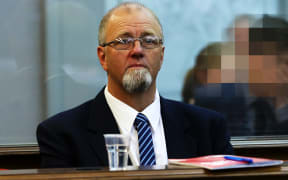A Dutch forensic scientist has spent the day defending her findings that matter found on Mark Lundy's shirt was human brain.

Forensic specialist Dr Laetitia Sijen - pictured earlier in the week at the trial. Photo: RNZ / Alexander Robertson
Mark Lundy, 56, is accused of murdering his 38-year-old wife, Christine, and seven-year-old daughter, Amber, whose bodies were found in their Palmerston North home on 30 August 2000; the Crown claims Mr Lundy killed his wife for her insurance money and Amber because she saw what he was doing to her mother.
Key points from day 18:

Mark Lundy Photo: RNZ / Alexander Robertson
Samples from smears found on a polo shirt belonging to Mr Lundy were taken to Laetitia Sijen, from the Netherlands Forensic Institute's (NFI) department of human biological traces, for identification.
She told the High Court at Wellington she used an RNA "brain plex" to conclude there was evidence of human brain in one of the smears. It was tested against brain tissue from seven animals, including chicken and cat, to reach the conclusion.
Ribonucleic acid, or RNA, is present in all cells and acts as a messenger to carry instructions from DNA. Everyone has different DNA but blood cells have the same RNA.
Defence lawyer David Hislop, QC, questioned her today and yesterday on the fact the brain plex had never been used before and said a defence witness - a German forensic scientist - took issue with the process and its reliability. Another expert had said there was "striking" variability in RNA methods in the forensic community.
Dr Sijon agreed there was variability but said it was not striking as individual labs each assessed the most suitable testing method for them and stuck with it; just as labs used different manufacturers for DNA typing kits, RNA testing methods varied.
As well, her department of human biological traces at the NFI had the advantage of being a large organisation, which received about 45,000 products for testing in 2013, from which they looked at RNA in 40-50 cases. Smaller labs might have cause to look at only one RNA case a year so it was not worth them validating a testing process.
The brain plex used on the tissue from Mr Lundy's shirt - which earlier evidence has identified as being from Mrs Lundy - gave a positive result for human brain tissue in seven out of 12 tests, giving a probability of 58 percent.

Mark Lundy's lead lawyer David Hislop Photo: RNZ / Alexander Robertson
Mr Hislop put it to Dr Sijon she could not discount the likelihood that if she did more tests then there would be more negative results.
"I do not agree with that rationale," she said.
Mr Hislop yesterday said the brain plex had never been used before and had not been subjected to the scrutiny of the scientific community.
Dr Sijen agreed it was the first time it had been used but that the strategy had been scrutinised three times.
"The forensic community is a community that challenges itself, because we need to know," she said.
Yesterday, Mr Hislop also questioned Dr Sijon on the level of mistakes made at the NFI. Today, prosecutor Philip Morgan, QC, showed that the NFI analysed 132,456 samples in 2012, of which there were 572 "notifications" of errors; notifications could include something as simple as a typing error, and many were administrative issues, Dr Sijon said.
"It is about learning from your mistakes, and many of those mistakes are seen and handled before the report goes out," she said.
The trial, before Justice Simon France and a jury of seven men and five women, is expected to run until about Easter.
* Clarification - For the avoidance of doubt, please note that Radio New Zealand reporter Sharon Lundy is no relation to Mark Lundy.





